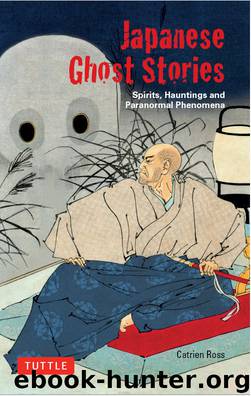Japanese Ghost Stories: Spirits, Hauntings, and Paranormal Phenomena by Catrien Ross

Author:Catrien Ross [Ross, Catrien]
Language: eng
Format: epub, mobi
Tags: Non-Fiction, Horror
ISBN: 4805310928
Google: yYLQAgAAQBAJ
Amazon: B005LPUEKA
Barnesnoble: B005LPUEKA
Goodreads: 16307002
Publisher: Tuttle Publishing
Published: 2010-01-01T05:00:00+00:00
Throughout Aomori, as well as in neighboring Akita and Iwate prefectures, the relics found at various archaeological sites underscore this dynamically creative period of Japan’s Stone Age. For more than one thousand years, the northeast region now known as Tohoku was evidently a thriving cultural center. Most characteristic of the Jomon era is the intricate jomon (literally, “cord-patterned”) earthenware, of complex design and exquisite craftsmanship. According to a diary kept by the Kitajima family, who from their base at Nameoka Castle governed south Tsugaru in Aomori during the early seventeenth century, much rare pottery was found in their day. Enthusiastic collectors flourished in the Edoera, and buying and selling of pottery took place even in foreign countries, as awareness of Jomon artwork spread.
But first-class pottery fails to explain adequately the costume of the shakoki dogu, which could have been nothing like the everyday simple dress of Jomon people, who hunted with bows and arrows and fished with bone fishhooks and harpoons. Is this fantastic clay doll simply the product of an artist’s rich imagination? Or was it created to capture the memory of an alien connection that was celebrated thereafter in careful ritual? Today the 34.5-centimeter-tall statue fortuitously found by the farmer is showcased at the Tokyo National Museum, where it still retains its ancient secret. The field, on the other hand, has become an Aomori tourist attraction marked by a towering white plaster replica of the figurine, an enormous reminder of the world’s many unknowns.
Another mystery turns up at Oyu, a small resort in Akita, between Lake Towada and Hachimantai. In the foothills southeast of the town stands the Oyu Stone Circle, thought to date back some four thousand years, to Japan’s prehistoric age. Considered the best example of approximately thirty similar stone circles located throughout Tohoku and also in Hokkaido, the Oyu Stone Circle is actually two large circles, one situated inside the other. Between the perimeters of the inner and outer circles is a sundial, with rocks laid out like spokes radiating from this center. The stones were dragged from some twelve kilometers away, a considerable distance at the time. The Oyu Stone Circle was serendipitously discovered by government surveyors in 1931, and the site has since been designated as a historical relic. As with the shakoki dogu, there are numerous theories to explain the circle’s existence. More recently, the site was used to fuel military propaganda touting Japan’s cultural superiority during World War II. At other stone circles have been found pottery of rare design, such as collections of small-lipped vases. Often, dug under the stone circles, there are oval hollows with diameters of 1.5 meters and depths of seventy centimeters. These may have been used as graves or for special worship. Researchers also believe corpses may have been buried with arms and legs folded into the body with the head facing west. As a graveyard, the circle could have started out small and increased in size. The foundations of Jomon pit houses, partially underground dwellings
Download
Japanese Ghost Stories: Spirits, Hauntings, and Paranormal Phenomena by Catrien Ross.mobi
This site does not store any files on its server. We only index and link to content provided by other sites. Please contact the content providers to delete copyright contents if any and email us, we'll remove relevant links or contents immediately.
In Control (The City Series) by Crystal Serowka(35797)
The Wolf Sea (The Oathsworn Series, Book 2) by Low Robert(34719)
We Ride Upon Sticks by Quan Barry(34019)
Crowbone (The Oathsworn Series, Book 5) by Low Robert(33070)
The Book of Dreams (Saxon Series) by Severin Tim(32926)
The Daughters of Foxcote Manor by Eve Chase(23068)
Trainspotting by Irvine Welsh(21038)
Call Me by Your Name by André Aciman(19915)
Shot Through The Heart (Supernature Book 1) by Edwin James(18442)
The Secret History by Donna Tartt(18194)
The Girl from the Opera House by Nancy Carson(15388)
American King (New Camelot #3) by Sierra Simone(14896)
All the Missing Girls by Megan Miranda(14772)
Sad Girls by Lang Leav(13925)
Pimp by Iceberg Slim(13790)
The Betrayed by Graham Heather(12316)
The Betrayed by David Hosp(12217)
4 3 2 1: A Novel by Paul Auster(11802)
Still Me by Jojo Moyes(10802)
